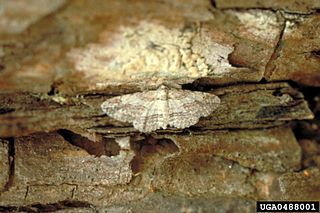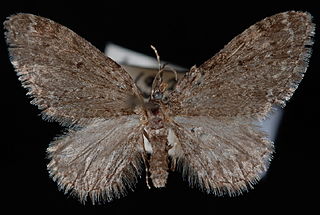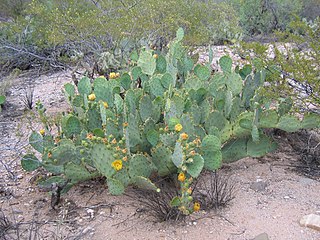
Cactoblastis cactorum, the cactus moth, South American cactus moth or nopal moth, is native to Argentina, Paraguay, Uruguay and southern Brazil. It is one of five species in the genus Cactoblastis that inhabit South America, where many parasitoids, predators and pathogens control the expansion of the moths' population. This species has been introduced into many areas outside its natural range, including Australia, the Caribbean, and South Africa. In some locations, it has spread uncontrollably and was consequently classified an invasive species. However, in other places such as Australia, it has gained favor for its role in the biological control of cacti from the genus Opuntia, such as prickly pear.

Opuntia engelmannii is a prickly pear common across the south-central and Southwestern United States and northern Mexico. It goes by a variety of common names, including desert prickly pear, discus prickly pear, Engelmann's prickly pear in the US, and nopal, abrojo, joconostle, and vela de coyote in Mexico.

Opuntia stricta is a species of large cactus that is endemic to the subtropical and tropical coastal areas of the Americas, especially around the Caribbean. Common names include erect prickly pear and nopal estricto (Spanish). The first description as Cactus strictus was published in 1803 by Adrian Hardy Haworth. In 1812 he moved the species to the genus Opuntia.

Opuntia bentonii was proposed by some botanists to be a synonym of Opuntia stricta. However, O. bentonii, which grows in Texas, is separate and distinct from O. stricta.O. bentonii was clearly described by Griffiths in 1911. Along with O. stricta,O. bentonii was one of the pest pears of Australia in the early Twentieth Century.

Opuntia, commonly called the prickly pear cactus, is a genus of flowering plants in the cactus family Cactaceae, many known for their flavorful fruit and showy flowers. Cacti are well-adapted to aridity, however, they are still vulnerable to alterations in precipitation and temperature driven by climate change. Prickly pear alone is more commonly used to refer exclusively to the fruit, but may also be used for the plant itself; in addition, other names given to the plant and its specific parts include tuna (fruit), sabra, sabbar, nopal from the Nahuatl word nōpalli, nostle (fruit) from the Nahuatl word nōchtli, and paddle cactus. The genus is named for the Ancient Greek city of Opus, where, according to Theophrastus, an edible plant grew and could be propagated by rooting its leaves. The most common culinary species is the "Barbary fig".

Prickly pears include a number of plant species that were introduced and have become invasive in Australia.

Melitara dentata, the North American cactus moth, is a moth of the family Pyralidae. The species was first described by Augustus Radcliffe Grote in 1876. It is native to western North America, where it is widespread from Alberta to southern Arizona and central Texas. It is an introduced species in Hawaii.
Melitara prodenialis is a moth of the family Pyralidae described by Francis Walker in 1863. It is native to North America, where it is known from south-eastern New York to Florida along the Atlantic coastal plain, and west to eastern Oklahoma and north-central and south-eastern Texas. It is an introduced species in Hawaii. It is a special concern species in Connecticut.

Iridopsis pergracilis, the cypress looper moth, is a moth of the family Geometridae. The species was first described by George Duryea Hulst in 1900. It is found in the US from Maryland to Florida.

Monoptilota is a genus of snout moths. It was described by George Duryea Hulst in 1900. It contains only one species, the lima-bean vine borer moth, which is found in the central and south-eastern parts of the United States.

Zophodia is a genus of snout moths in the subfamily Phycitinae. It was erected by Jacob Hübner in 1825.

Melitara is a genus of snout moths in the subfamily Phycitinae. It was described by Francis Walker in 1863. Some sources list it as a synonym of Zophodia, while others retain it as a valid genus.
Melitara texana is a species of snout moth in the genus Melitara. It was described by Herbert H. Neunzig in 1997 and is found in southern Texas and adjacent Mexico.
Melitara doddalis is a species of snout moth in the genus Melitara. It was described by Harrison Gray Dyar Jr. in 1925, and is found in the United States in southern Arizona, southern New Mexico, south-western Texas and in northern Mexico.
Melitara subumbrella is a species of snout moth in the genus Melitara. It was described by Harrison Gray Dyar Jr. in 1925. It is widespread in western North America, from southern Alberta and Saskatchewan to southern Arizona, central Texas, southern New Mexico and south-eastern California.
Ozamia clarefacta is a species of snout moth in the genus Ozamia. It was described by Harrison Gray Dyar Jr. in 1919. It is found in Texas and Mexico

Eupithecia annulata, the larch pug moth, is a moth in the family Geometridae. The species was first described by George Duryea Hulst in 1896. It is found in North America from British Columbia north to the Yukon, east to Newfoundland and Labrador and south to California and Colorado.

Opuntia macrorhiza is a common and widespread species of cactus with the common names plains pricklypear or prairie pricklypear or western pricklypear. It is found throughout the Great Plains of the United States, from Texas to Minnesota, and west into the Rocky Mountain states to New Mexico, Utah, and perhaps Idaho, with sporadic populations in the Mississippi and Ohio Valleys. It is also reported from northern Mexico in the states of Chihuahua, Sonora, Coahuila, Nuevo León, Durango, Tamaulipas, and San Luís Potosí., though all Arizona and Mexican records should be considered with caution due to confusion with other similar species. The species is cultivated as an ornamental in other locations.

Opuntia lindheimeri or Texas prickly pear is a species of cactus native to North America. It is native to Mexico and the United States, where its populations are primarily in Texas.

Opuntia alta is a cactus species in the genus Opuntia. It is a large plant, with some older specimens forming trees to 4.6 metres (15 ft) tall. It is a naturally-occurring hybrid of Opuntia engelmannii var. lindheimeri and O. stricta native to Texas and Louisiana.













